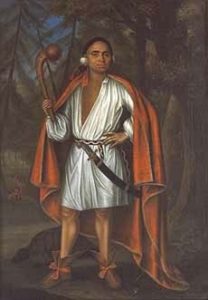Four years after the Treaty of Paris, the Lower Creeks met in council – April 10, 1787. McGillivray addressed the naivete of Creek chiefs, while another group was held hostage by the Americans, to “run the line, as agreed,” with the following remarks:
It is not so long since, but you must remember how one of these Powers made violent efforts even upon us, the white people, their children. But to tell you what is done by others of them upon people of your color, towards the mid-day sun, would fill you with horror. Ought we not, therefore, to grasp one another with a strong arm of friendship, the more easily to repel these foreigners?i [emphasis added]
Evidently, McGillivray was sensitive to the race war waged by the colonists against Indians.
After years of tit-for-tat skirmishes and depredations, the United States decided to sue for peace. Commissioners were sent into Creek country to seduce McGillivray to agree to a cessation of hostilities. In 1790, McGillivray took a coterie of Creeks to New York, the seat of U.S. government, to negotiate a treaty.ii That exclusive group of individuals included his nephews, heirs to his wealth and political position. In particular, David Tate, son of his maternal half sister, Sehoy, accompanied him. Ten-year-old Tate was impressed with the pomp and circumstance accorded his first trip outside the Creek Nation. McGillivray was feted at the personal residence of Henry Knox, Secretary of War. At the conclusion of negotiations, young David was left in the care of Knox.
. . .
David Tate was educated at Philadelphia under a secret article of the 1790 Treaty.
i“The Library of Congress,” A Century of Lawmaking for a New Nation: U.S. Congressional Documents and Debates, 1774 – 1875,” American State Papers, Senate, 1st Congress, 1st Session , Indian Affairs, Vol. 1, page 22. http://memory.loc.gov/cgi-bin/ampage?collId=llsp&fileName=007/llsp007.db&recNum=23 (Accessed: May 5, 2016).
iiLinda Langley, “The Tribal Identity of Alexander McGillivray: A Review of the Historical And Ethnographic Data, Louisiana History” The Journal of the Louisiana Historical Association, Vol. 46, No. 2 (Spring, 2005), pp. 231-239.
iii“An open door policy,” HenryKnoxMuseum.org http://www.knoxmuseum.org/henry-knox/the-house/ (Accessed: May 5, 2016).
ivLawrence M. Hauptman and Heriberto Dixon, “Cadet David Moniac: A Creek Indian’s Schooling at West Point, 1817-1822, Proceedings of the American Philosophical Society, Vol. 152, No. 3, September 2008.pg. 330.
©2016-2020 All rights reserved.
